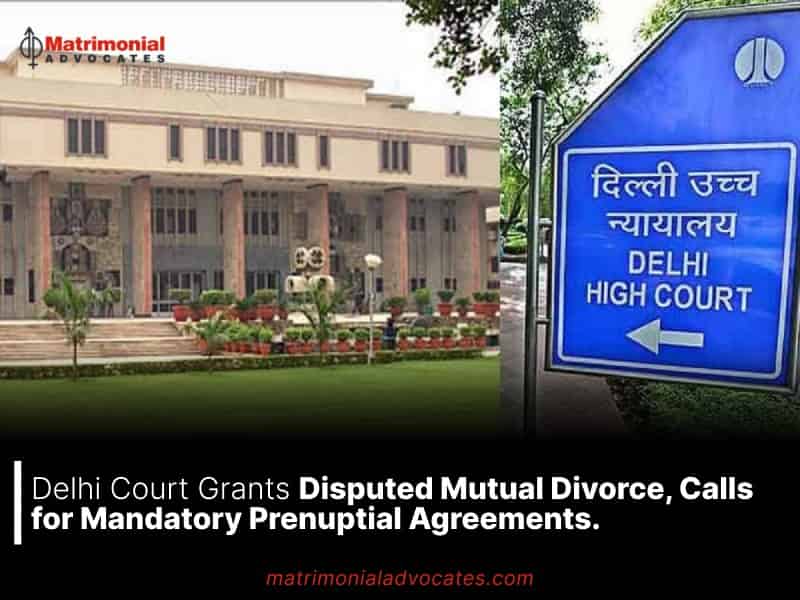
In a notable legal development, a Delhi Court issued a decree of mutual divorce pursuant to Section 13B of the Hindu Marriage Act, despite the wife’s protracted and resolute opposition to her husband’s divorce petition over the course of seven years. This distinctive case, characterized by the absence of a formally filed mutual consent divorce petition by the parties, prompted the Court, in recognition of the marked matrimonial discord marked by mutual cruelty, to exercise its discretion in favor of granting the divorce.
Justice Harish Kumar, serving as the Principal Judge of the Family Court at the Patiala House Court in New Delhi, articulated in a comprehensive 89-page judgment that, in light of the provisions contained in Section 10 of the Family Court Act—a specialized legal framework—the Court possesses the authority to dispense with the formal requisites prescribed under Section 13B of the Hindu Marriage Act when confronted with cases in which the parties have lived apart for a duration exceeding one year, exhibit an inability to reconcile, unequivocally manifest their unwillingness to cohabit, and jointly seek the dissolution of their matrimonial bond.
The Petitioner was represented by Advocate Varun Sharma, whereas Advocates Prashant Mendiratta and Aditi Chaudhary represented the Respondent.
Background: The parties, both gainfully employed as bank officials, solemnized their matrimonial union through Hindu rituals in 2011, which eventually resulted in the birth of a daughter in 2014. However, the emergence of irreconcilable differences and discordant circumstances precipitated a protracted marital dispute. Subsequently, in 2016, the husband initiated divorce proceedings under Section 13(1)(i-a) of the Hindu Marriage Act before the Family Court in Bandra, Mumbai. The wife contested the divorce petition and concurrently invoked the provisions of the Protection of Women from Domestic Violence Act, 2005, by filing a miscellaneous application encompassing various sections. This legal battle entailed the submission of numerous miscellaneous applications by both parties. Eventually, the Supreme Court transferred the case to the Family Court at the Patiala House Court in New Delhi.
As the Court meticulously deliberated upon the matter, it was discerned that, despite the couple’s consistent resolve to sever their matrimonial ties from the inception of the litigation, they remained unable to achieve concurrence regarding divorce by mutual consent, predominantly due to disputes surrounding other ancillary matters.
The judgment underscored that the wife, while initially expressing a desire for “mukti” (freedom or emancipation) from the relationship and an aspiration to lead a peaceful life detached from her husband, ultimately came to recognize that she was opposing her husband’s divorce petition, having not sought divorce herself. Subsequently, she sought to rectify this incongruity by filing an application under Order VI Rule 17 of the Civil Procedure Code, seeking to amend her response to incorporate a counter-plea for divorce on the grounds of cruelty.
Nevertheless, the Court issued a mutual divorce decree under Section 13B of the Hindu Marriage Act, while concurrently furnishing comprehensive observations and elucidating the rationale underlying the grant of a ‘mutual divorce’ in a contested case.
The presiding Judge emphasized that all the requisite elements specified under Section 13-B were present, with the exception of formal procedural compliance. The Court clarified that the procedural formality mandated by Section 13-B of the HMA entails the joint submission of a divorce petition by both parties, collectively seeking a decree of divorce. However, in the present case, the parties had unequivocally expressed their willingness to terminate their marital relationship over the course of the preceding seven years, albeit not in strict conformity with the specific formalities delineated under Section 13B of the HMA. This incongruity had resulted in needless protraction and legal wrangling, engendered by the distinct positions adopted by the parties.
The Court further referring to the above-para asked, “If all the ingredients as required under Section 13B of the HMA are otherwise available in the matter, wouldn’t it be in the interest of the parties in particular and of the society in general to extend the relief of Section 13B of the HMA to those who for any reason are unable to follow or observe the particular form required under Section 13B?”. The Court also stated that, “Wouldn’t it be recognising the further changing dynamics of modern relationship and going about more practical to ameliorate the suffering of person in unfortunate matrimonial tie?”
In response to the aforementioned contention, the Court underscores that in cases involving married individuals embroiled in a contentious matrimonial dispute replete with grave allegations, and in the absence of any prospect of reconciliation, denying the dissolution of their marriage solely due to the incapacity of the party initiating legal proceedings to substantiate the misconduct of the other party would amount to compelling the parties to endure continued hardship, irrespective of fault or its absence. Such denial of divorce would impose a form of psychological distress attributable to the legal system.
Advocating Mandatory Prenuptial Agreements: In its adjudication, the Court underscores the imperative of instituting obligatory prenuptial agreements executed under the auspices of a designated authority. This procedural endeavor encompasses counseling the parties with regard to potential pitfalls that may affect marriages for various reasons. Furthermore, the Court recommends obligatory reporting of any breaches of the agreement when they occur. Explicitly stated is the premise that the failure to report a breach would preclude the party allegedly at fault from subsequently asserting their non-reporting was based on the expectation of self-improvement.
Progress Towards No-Fault Divorces: Marking a substantial stride towards the concept of “no-fault divorces,” the Court, in its judgment, contemplates the possibility that the expressed willingness of the parties or their petitions to dissolve the marriage may be regarded as tantamount to mutual consent to terminate the marriage, without delving into the particular allegations proffered by the parties.
The Judge determines that, in this instance, instead of delving into the matter of attributing fault to one party or the other as a basis for justifying the dissolution of the marriage, it is prudent to terminate the marriage under the aegis of Section 13B of the Hindu Marriage Act, 1955. The Court regards the respective pleas for dissolution submitted by both parties (assigning blame to the other party) as constituting their mutual consent to terminate the marriage. The effect of this dissolution would be effective from the date of the Judge’s pronouncement.
The Judge also acknowledges that some observers might interpret the Court’s decision as an endeavor to evade its obligation to meticulously review the evidence. Nevertheless, the Judge elucidates that in certain cases, it is in the best interests of the state and society to expeditiously resolve contentious matters, particularly those of a familial nature, to preserve domestic harmony.
“In the present case if prayer of husband or wife is accepted holding the other spouse guilty of matrimonial offense, the person against whom findings would go will take the matter to higher forum thus drag the other into rigmarole of further round of litigation with added agony and harassment. Similarly, refusal of their respective prayer, if they failed to prove their allegation, would also lead to law induced mental cruelty as discussed above”, stated the Jugdement.
Child Custody and Financial Obligation Determinations: The Court has addressed issues concerning the custody of the child and the allocation of financial responsibilities. In the child’s best interests, the Court has appointed both parents as joint legal guardians with shared responsibilities for the child’s educational and extracurricular activities. Stressing the importance of the father’s role, particularly given the proximity within the Gurgaon community, the Court has directed the mother to include the father’s name in the child’s school records. Furthermore, the Court has granted the father daily access to the child and allowed him to spend weekends with her. The Court has emphasized that the mother, who has been the primary caregiver for an extended period, must ensure the child’s compliance with visitation arrangements.
Additionally, the Court has ordered the child to consult with a child psychologist, focusing on addressing any unwarranted fears or concerns she might have regarding her father and helping her appreciate the significance of his role in her life. The Court has encouraged frequent interactions between the child and her father, particularly during vacations and weekends.
In the context of financial support, the Court has expressed reservations about the mother’s claimed expenses, suggesting they may be excessive. Consequently, the Court has categorized the expenses into essentials, non-essential discretionary items, and luxury expenditures. Guided by the respective incomes of both parents, the Court has mandated that they equally share the financial responsibility for 50% of the child’s justified expenses, focusing solely on necessary and discretionary items.
The decision has garnered significant attention on social media, with many lauding it as a commendable and forward-thinking legal choice. Deepika Narayan Bhardwaj, a filmmaker and social activist specializing in men’s issues, has also praised the decision, describing it as remarkable and progressive.
Bhardwaj stated,”There’s no point making young men & women doing rounds of courts for years for divorce when the marriage has completely broken down. This judgment by Judge Harish Kumar sets a precedent for its balanced nuance on matters of maintenance, custody and divorce. Prenuptial agreements are need of the hour along with shared parenting. For a balanced society we need to treat both men and women as equals and treat them as equal beings. “





